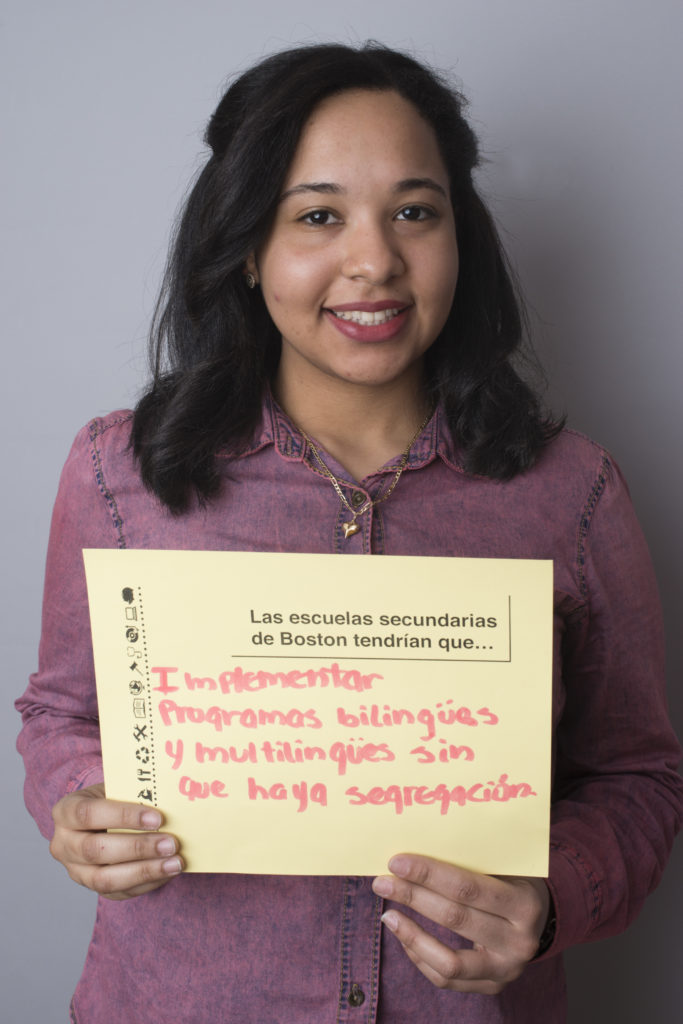
By Lorian De Lahoz Cruz
Having moved to United States from the Dominican Republic, I felt a huge sense of relief when I found out that I’d be attending the only two-way bilingual high school in the state. I have had many positive experiences at the Margarita Muñiz Academy, but there is something important missing: cultural diversity. I am surrounded by students that look and speak like me: Latinos. This kind of segregation is something that Boston Public Schools needs to change.
For families interested in two-way Spanish/English education, Boston Public Schools has several models, such as the Sarah Greenwood School for grades K1 through 4 and the Rafael Hernandez and Joseph Hurley schools for grades K1 through 8. However, these schools are 70 percent, 92 percent and 72 percent Latino, respectively. Like me, these students aren’t benefiting from the advantages that a diverse classroom affords.
At a diverse school, the students spend time talking with people who are different from them, opening their minds, exchanging ideas, and improving their lifestyles.
¨In a diverse classroom the students have the opportunity to experience new cultures and develop new skills that can impact their life in a positive way,¨[1] said Dr. Frances Esparza, the assistant superintendent at the office of English learners for Boston Public Schools. Esparza believes the district should do more to grow these programs by informing all parents, not just Latino parents, that a multilingual and multicultural education is an asset. In sum, BPS should establish multilingual education that goes from 5th through 12th grade.
A culturally diverse school has a deep impact on students. According to Esparza, “The student performs better when they are in a diverse classroom or school.”[2] When the school is multilingual a newly-arrived immigrant can feel more comfortable, because there may be others that speak the same language or have the same ethnicity. Also, students in a culturally-diverse school have a deeper understanding and respect for other cultures. At a diverse school, the students spend time talking with people who are different from them, opening their minds, exchanging ideas, and improving their lifestyles.
In a culturally and linguistically diverse classroom, students develop awareness for language and understand that there are many ways to communicate their ideas. Students can transfer their native language skills and learn English faster! Multilingual students can transfer their knowledge of one language to any other language, and they can have the opportunity to navigate in many cultures. Also, the more languages students speak, the more global opportunities they will have to find employment in any country. [3]
There are several successful multilingual school systems that Boston Public Schools can aspire to. One excellent example is the educational system used in Germany. Besides German, students learn English and Italian. Then in high school they continue learning these languages and add a fourth language like Latin. “At the International Community High School located in the South Bronx, the students have the opportunity to reach their academic goals while expanding their horizons by learning about the lives and histories of their classmates.”[4] After school, some of the programs offered are German and French. The students graduate with academic skills, learn one of these two languages, and have an understanding of other cultures.
Multilingual education can be controversial. Many think that the most important language in the Unites States is English, because it is the dominant language. They think if you come to the United States, you should forget about your native language. People need to remember that the United States is comprised of many different cultural groups, and that this country does not have an official language. Some people also think that by learning more than one language, students are at risk of not truly learning any language. This may be the case if people are illiterate in their native language, but if a student is strong in his or her first language he can transfer those literacy skills to the language he is learning.
The implementation of multilingual education in the Boston Public Schools will promote cultural, social, and intellectual development in every student. It will develop students’ linguistic skills, not only in their native languages but also in their second or even third language of study. More importantly, learning more than one language and learning about many cultures will benefit not just the students, but Boston as a whole.
- France Esparza, in discussion with author, January 25, 2016. ↑
- France Esparza. ↑
- Alison DeNisco, “Immigrant Surge Slows, but Challenges Remain, “District Administration, October 2015, 22, accessed December 3, 2015. ↑
- “Creating a Community of Learners,” International Community High School, accessed December 01, 2015, http://ichs.weebly.com/. ↑
You must be logged in to post a comment.